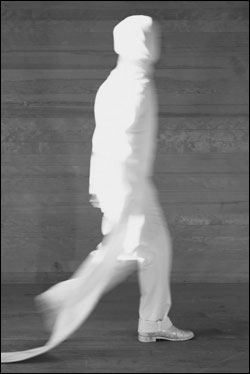I HAD EVERY intention of liking Partsong, an installation/performance put together by four writers, two musicians, a choreographer, and an artist from the brand-new indie-arts collective Testpattern (this is the group’s first project). The location is stunninga 1920s brick building on Lake Washington in Magnuson Parkand the people who put it together are sweet and hardworking, with laudably ambitious plans of making art outside the confines of museums and galleries. But Partsong, which continues through this weekend (9 p.m. Friday, Aug. 15 and Saturday, Aug. 16, $10, Sand Point Magnuson Park, Building 11, 206-405-4382), is an interminable ramble through clichés of avant-gardism.
The idea was to bring disciplines together and create an event that is part installation art, part dance, part music, and part, um, poetry, I guess, or whatever the obscure, disconnected phrases heard on tape and spoken by the performers are supposed to be (“from the shrapnel of last year’s rain,” “your theory on why theories are important laid out like abused armor,” that kind of thingafter a couple minutes it just sounded like “blah, blah, blah”). But there’s no clue as to what the various bits are supposed to have in common, other than self-importance and a labored pace. Like a lousy ballad singer who thinks a ponderous tempo automatically makes a song more meaningful, Testpattern has slowed everything to a crawl, from the whiney, droney soundtrack to the Butoh-style walking of the two main performers. As these two performersa man and a woman dressed in white suits, each dragging one long sleeve on the groundcontinued to blather on, I wished I hadn’t forgotten my flask and that I’d filled it with hemlock instead of Jim Beam. Was it really only an hour long? So said my watch, but it’s hard to tell when time itself turns to dust.
Beyond a vague sense of taking part in something hip and arty, none of it could have meant a thing to anyone. I’m sure this includes the creators themselves, who, as much as they claim to be “playing with received notions,” have made work that looks and sounds like most anything else from the history of dadaist, nonlinear, make-up-your-own-meaning art from John Cage to Laurie Anderson. And here a few words from critic Clement Greenberg are in order: “It’s one of avant-gardism’s great theoretical services to have demonstrated that the look, at least, of the unconventional, the adventurous, the advanced, can be standardized enough to be made available to the tritest sensibility.” Criminy, even Mike Myers knows this remember “Sprockets”?
The evening was lightened a bit by the good-natured rebellion of some of the audience members who passed directly through the strings of rock candy hung by artist Elizabeth Jameson, rather than going around the edges as they were supposed to. This produced the piece’s single moment of spontaneous beauty, as the rock candy necklaces, lit harshly from below, swayed with the memory of the people who had passed through them. I also really liked the final movement of the piece, a kind of stylized peasant dance choreographed by Amelia Reeber and performed in a space enclosed by paper hanging from the ceiling so the dancers were visible only from the waist down. And the production valuesthe lighting, sound, and overall staging were very smooth and professional throughout.
And that’s the thingthey’re so heroic, the artists who put this piece together, working so hard with so few resources, that I feel like a philistine pissing on their parade. But, goodness, what are they really trying to accomplish? Their considerable ambitions certainly don’t include attracting a general audience (the opening-night crowd of 60 or so was the same small village of faces familiar from any number of other local art events). Even an educated, curious audience will fail to appreciate this tedious nonsense. Testpattern member Julie Johnson told me that the group was formed out of backyard discussions between herself and the two other co-founders, Fionn Meade (who’s also one of the white-suited performers) and Matt McCarty, about ways to break down the barriers formed by traditional curatorial practices. That helps to explain why Partsong comes off as a grad-school assignment whose relevance will be lost on anyone not taking the same seminar.
I should mention that some people seemed to like Partsong. “You’re being a bitch,” said the friend I saw it with, who, as it happens, sewed the white suits of the two main performers. “It was beautiful. It was about death.” That much I agree withvery slow death.








